Abstract
Reduction in heart rate during submaximal exercise is often used to judge the progress of patients with ischaemic heart disease in the course of a physical training programme. Some patients, however, are treated with beta adrenergic blocking drugs and it remains controversial if chronic beta blockade influences the effects of training and if heart rate remains a useful guide in the evaluation of the state of training of these patients. Male postinfarction patients, 15 treated with and 15 without beta blockers, were trained for three months, three times a week. Cardiorespiratory results from uninterrupted incremental exercise tests before and after training were compared. In each subgroup, the heart rate and systolic blood pressure were significantly reduced. For heart rate the decrease after training became more pronounced with increasing work load and the overall reduction was significantly less in the beta blocker group compared with the patients not treated with beta blockers. For systolic blood pressure the training-induced reductions were more pronounced in the patients on beta blockers. The increase of peak oxygen uptake was similar in the patients with and without beta blockers, namely 36% and 34.5%. At submaximal exercise carbon dioxide output, pulmonary minute ventilation, and the respiratory exchange ratio were lower after training, and these effects of training were similar whether or not the patients were on beta blockers. The study shows that the usual effects of training are observed in patients on beta blockers, and that heart rate remains a useful guide to their evaluation throughout a physical training programme.
Full text
PDF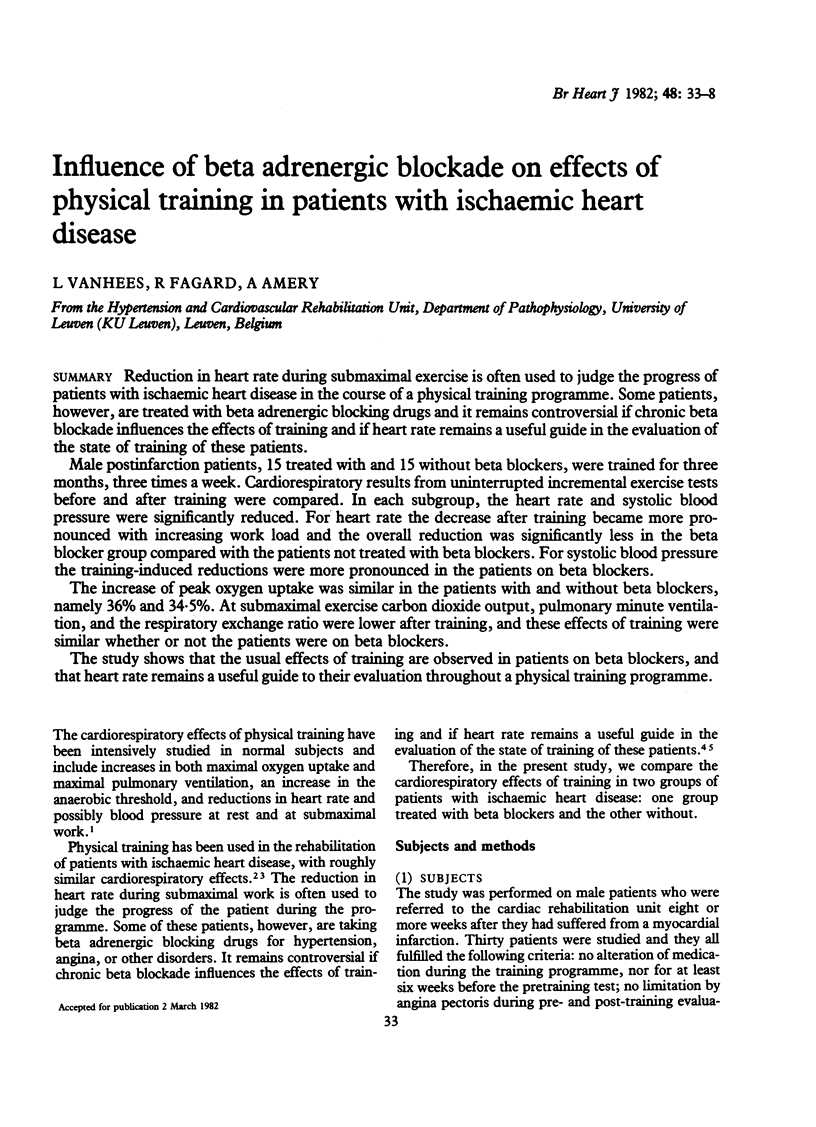
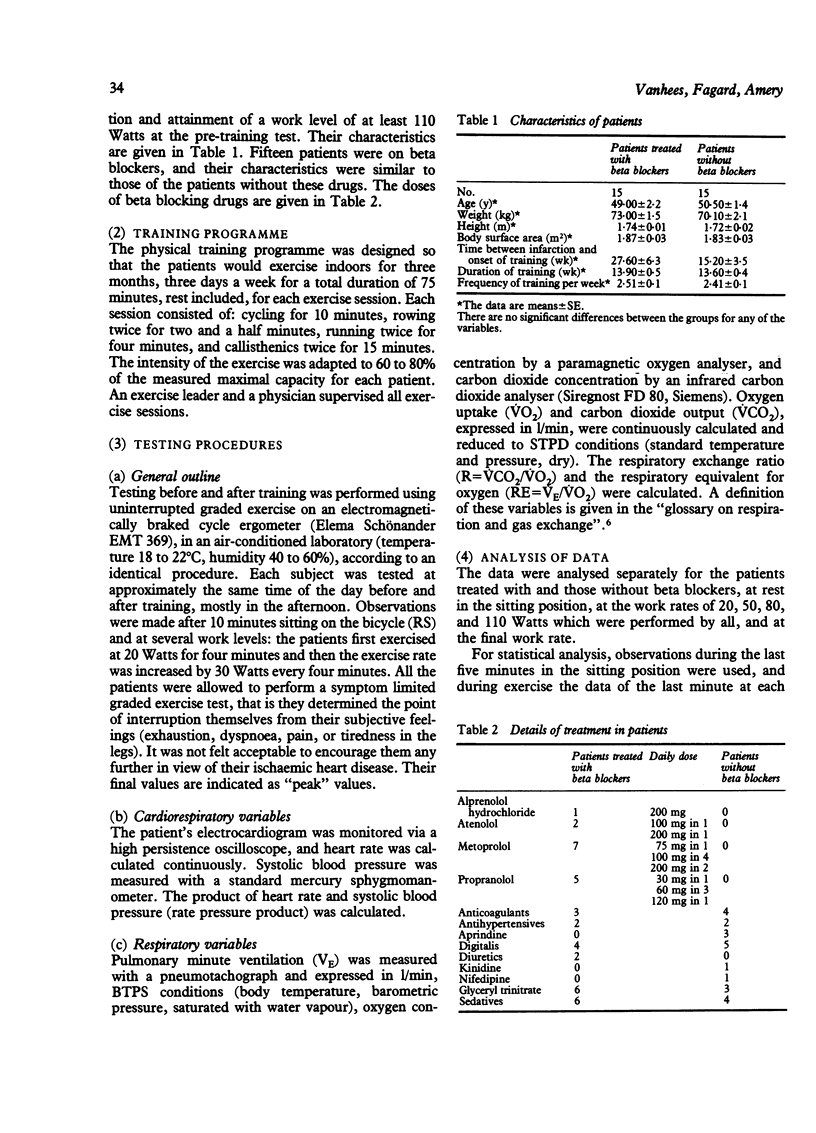
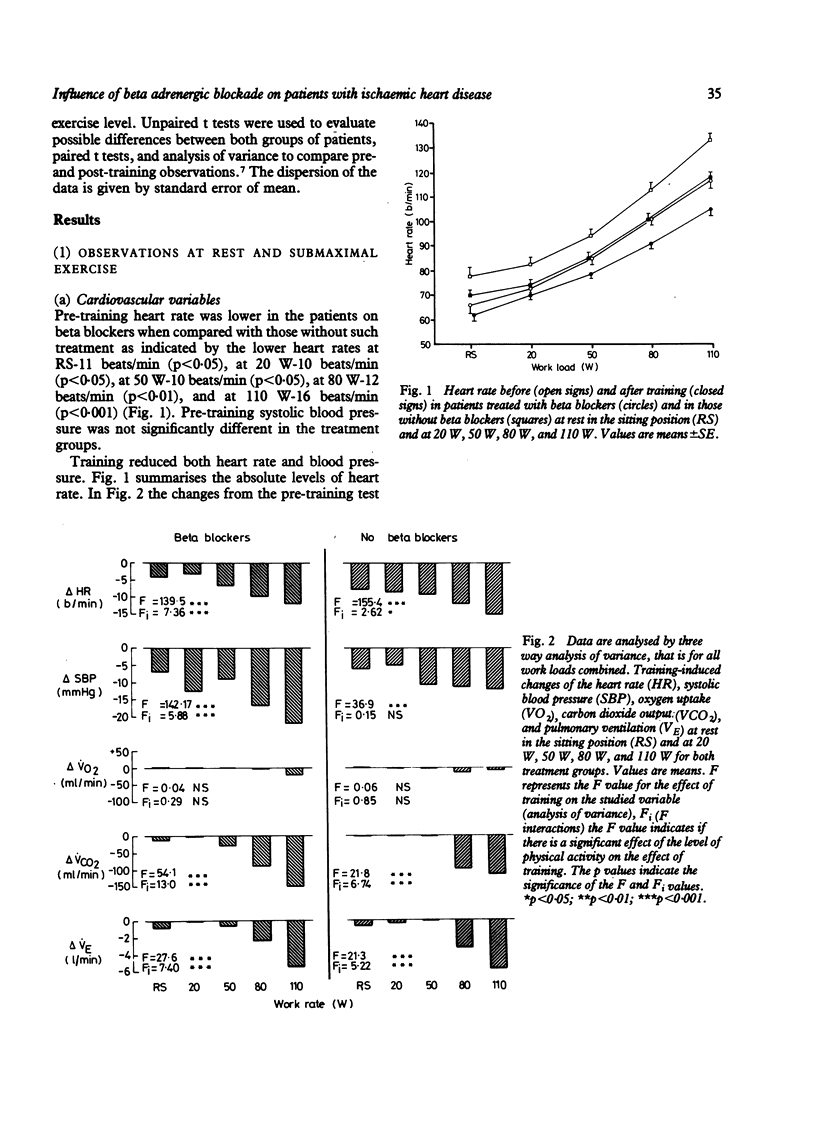
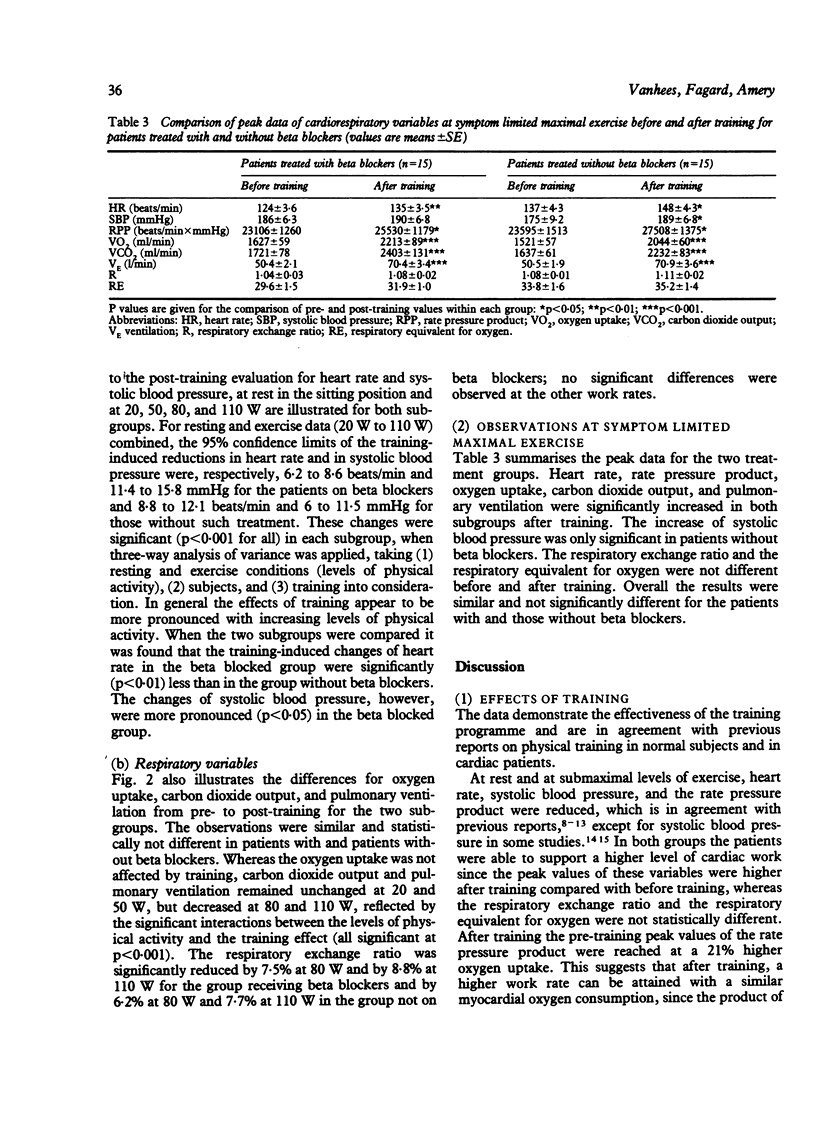
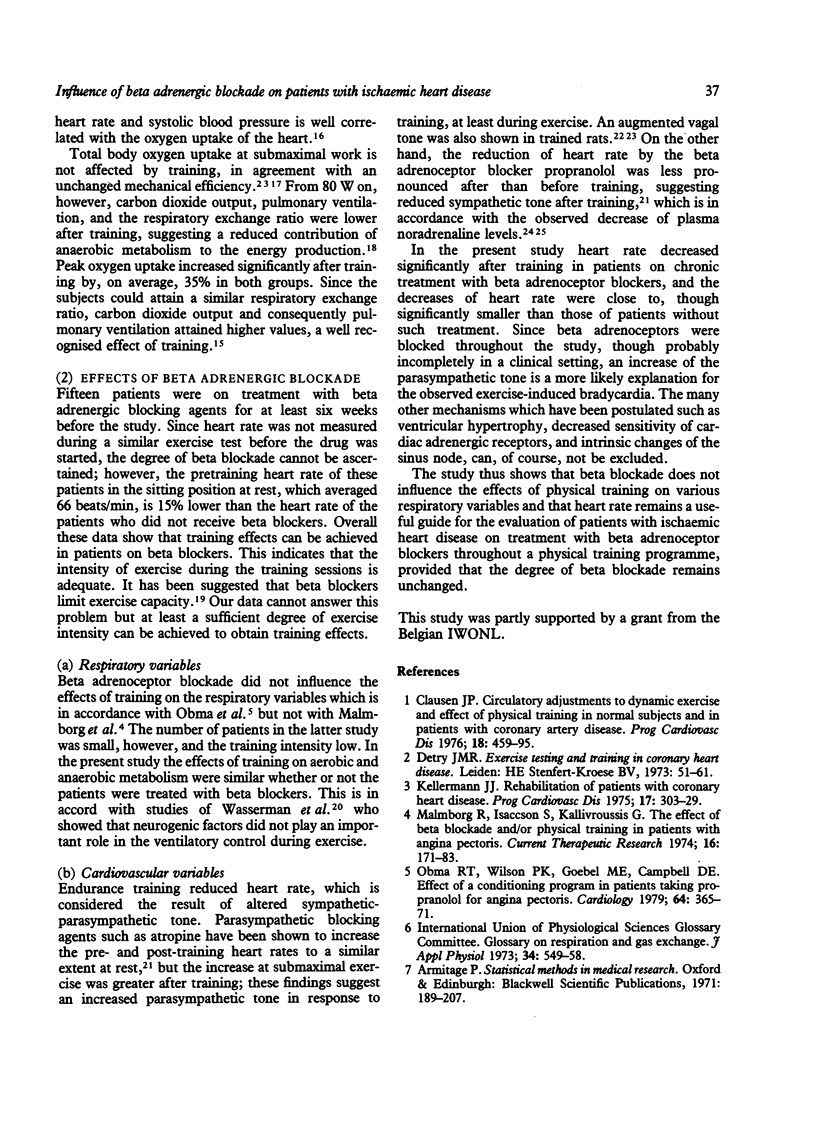
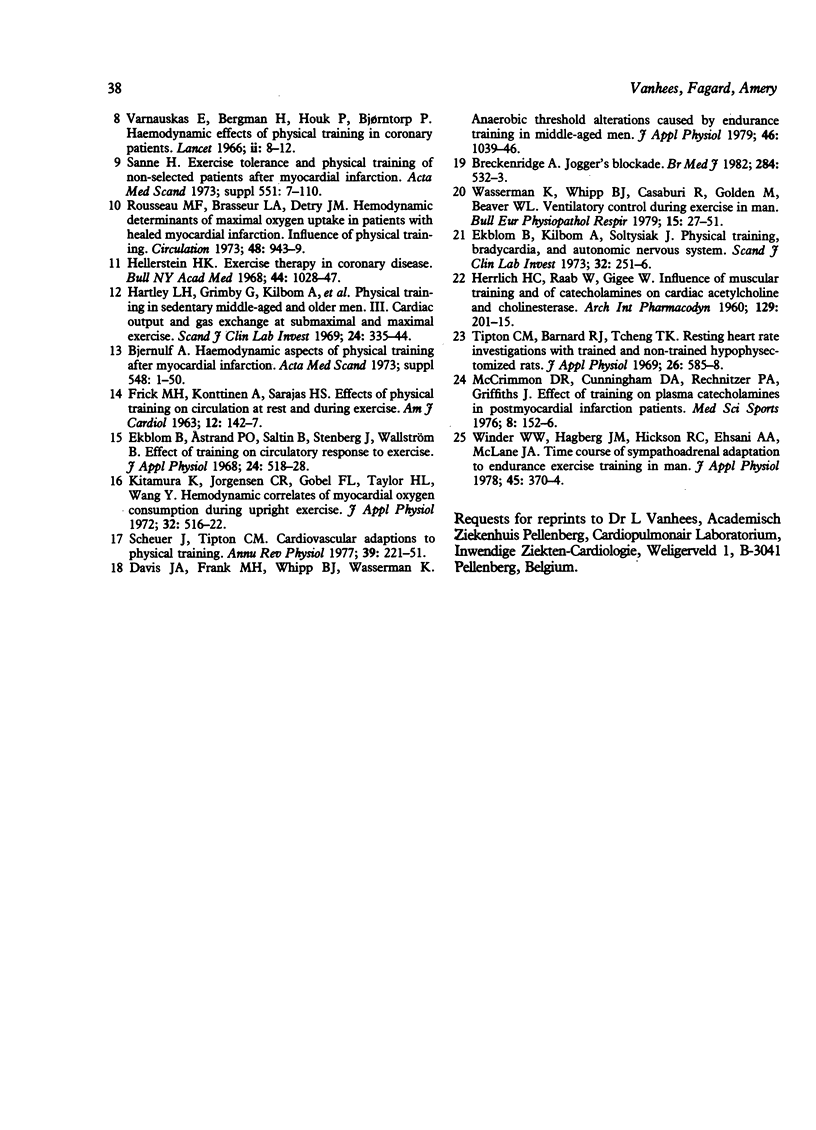
Selected References
These references are in PubMed. This may not be the complete list of references from this article.
- Bjernulf A. Haemodynamic aspects of physical training after myocardial infarction. Acta Med Scand Suppl. 1973;548:1–50. [PubMed] [Google Scholar]
- Breckenridge A. Jogger's blockade. Br Med J (Clin Res Ed) 1982 Feb 20;284(6315):532–533. doi: 10.1136/bmj.284.6315.532. [DOI] [PMC free article] [PubMed] [Google Scholar]
- Clausen J. P. Circulatory adjustments to dynamic exercise and effect of physical training in normal subjects and in patients with coronary artery disease. Prog Cardiovasc Dis. 1976 May-Jun;18(6):459–495. doi: 10.1016/0033-0620(76)90012-8. [DOI] [PubMed] [Google Scholar]
- Ekblom B., Astrand P. O., Saltin B., Stenberg J., Wallström B. Effect of training on circulatory response to exercise. J Appl Physiol. 1968 Apr;24(4):518–528. doi: 10.1152/jappl.1968.24.4.518. [DOI] [PubMed] [Google Scholar]
- Ekblom B., Kilbom A., Soltysiak J. Physical training, bradycardia, and autonomic nervous system. Scand J Clin Lab Invest. 1973 Nov;32(3):251–256. doi: 10.3109/00365517309082468. [DOI] [PubMed] [Google Scholar]
- FRICK M. H., KONTTINEN A., SARAJAS H. S. EFFECTS OF PHYSICAL TRAINING ON CIRCULATION AT REST AND DURING EXERCISE. Am J Cardiol. 1963 Aug;12:142–147. doi: 10.1016/0002-9149(63)90303-5. [DOI] [PubMed] [Google Scholar]
- HERRLICH H. C., RAAB W., GIGEE W. Influence of muscular training and of catecholamines on cardiac acetylcholine and cholinesterase. Arch Int Pharmacodyn Ther. 1960 Dec 1;129:201–215. [PubMed] [Google Scholar]
- Hartley L. H., Grimby G., Kilbom A., Nilsson N. J., Astrand I., Bjure J., Ekblom B., Saltin B. Physical training in sedentary middle-aged and older men. 3. Cardiac output and gas exchange asubmaximal and maximal exercise. Scand J Clin Lab Invest. 1969 Dec;24(4):335–344. doi: 10.3109/00365516909080170. [DOI] [PubMed] [Google Scholar]
- Kellermann J. J. Rehabilitation of patients with coronary heart disease. Prog Cardiovasc Dis. 1975 Jan-Feb;17(4):303–328. doi: 10.1016/s0033-0620(75)80020-x. [DOI] [PubMed] [Google Scholar]
- Kitamura K., Jorgensen C. R., Gobel F. L., Taylor H. L., Wang Y. Hemodynamic correlates of myocardial oxygen consumption during upright exercise. J Appl Physiol. 1972 Apr;32(4):516–522. doi: 10.1152/jappl.1972.32.4.516. [DOI] [PubMed] [Google Scholar]
- Malmborg R. O., Isacsson S. O., Kallivroussis G. The effect of beta blockade and-or physical training in patients with angina pectoris. Curr Ther Res Clin Exp. 1974 Mar;16(3):171–183. [PubMed] [Google Scholar]
- McCrimmon D. R., Cunningham D. A., Rechnitzer P. A., Griffiths J. Effect of training on plasma catecholamines in post myocardial infarction patients. Med Sci Sports. 1976 Fall;8(3):152–156. doi: 10.1249/00005768-197600830-00003. [DOI] [PubMed] [Google Scholar]
- Obma R. T., Wilson P. K., Goebel M. E., Campbell D. E. Effect of a conditioning program in patients taking propranolol for angina pectoris. Cardiology. 1979;64(6):365–371. doi: 10.1159/000170634. [DOI] [PubMed] [Google Scholar]
- Rousseau M. F., Brasseur L. A., Detry J. M. Hemodynamic determinants of maximal oxygen intake in patients with healed myocardial infarction: influence of physical training. Circulation. 1973 Nov;48(5):943–949. doi: 10.1161/01.cir.48.5.943. [DOI] [PubMed] [Google Scholar]
- Scheuer J., Tipton C. M. Cardiovascular adaptations to physical training. Annu Rev Physiol. 1977;39:221–251. doi: 10.1146/annurev.ph.39.030177.001253. [DOI] [PubMed] [Google Scholar]
- Tipton C. M., Barnard R. J., Tcheng T. K. Resting heart rate investigations with trained and nontrained hypophysectomized rats. J Appl Physiol. 1969 May;26(5):585–588. doi: 10.1152/jappl.1969.26.5.585. [DOI] [PubMed] [Google Scholar]
- Varnauskas E., Bergman H., Houk P., Björntorp P. Haemodynamic effects of physical training in coronary patients. Lancet. 1966 Jul 2;2(7453):8–12. doi: 10.1016/s0140-6736(66)91743-0. [DOI] [PubMed] [Google Scholar]
- Wasserman K., Whipp B. J., Casaburi R., Golden M., Beaver W. L. Ventilatory control during exercise in man. Bull Eur Physiopathol Respir. 1979 Jan-Feb;15(1):27–51. [PubMed] [Google Scholar]
- Winder W. W., Hagberg J. M., Hickson R. C., Ehsani A. A., McLane J. A. Time course of sympathoadrenal adaptation to endurance exercise training in man. J Appl Physiol Respir Environ Exerc Physiol. 1978 Sep;45(3):370–374. doi: 10.1152/jappl.1978.45.3.370. [DOI] [PubMed] [Google Scholar]


